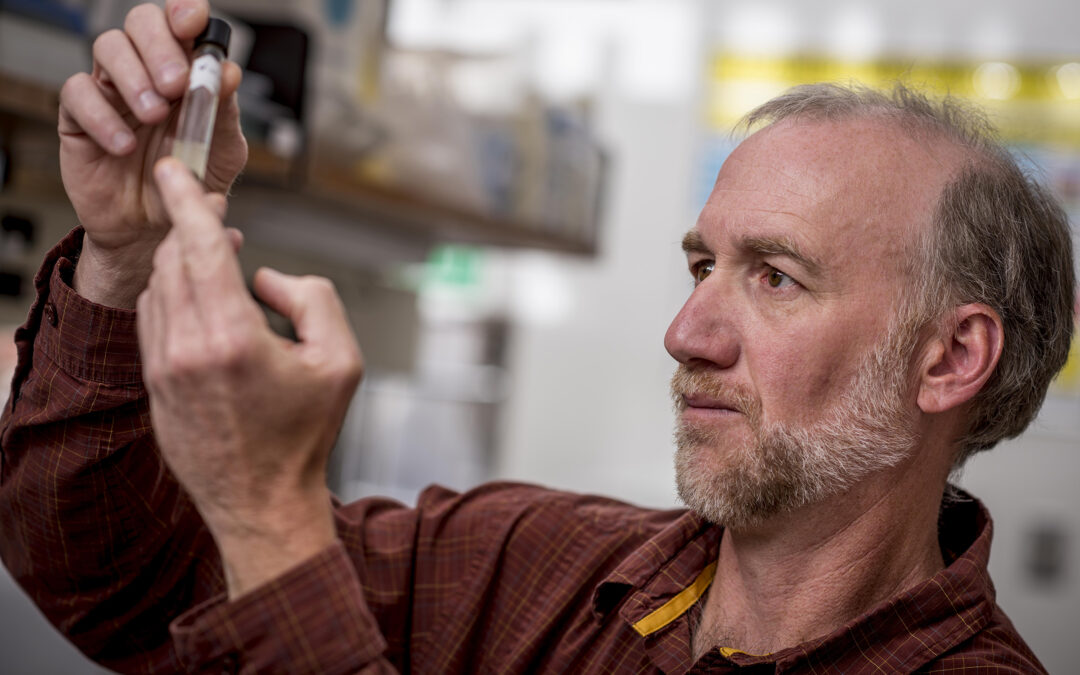Professor Loren Buck, environmental physiologist and associate director of Northern Arizona University’s Center for Bioengineering Innovation (CBI), is leading a new project that has the potential to change nothing less than the way scientists understand life on earth.
Titled “Predicting vertebrate responses to a changing climate: modeling genomes to phenomes to populations (G2P2PoP),” the project is designed to tackle one of the most important challenges facing the field of biology today: understanding the relationship between an organism’s DNA (its genome) and the set of characteristics that result from genomic expression (its phenome)—and how these relationships emerge at the population level.
Buck, who recently received a $540,000 grant from the National Science Foundation along with co-principal investigators Allyson Hindle from Harvard Medical School and Nika Galic from the University of Minnesota, will begin this groundbreaking project by launching a Research Coordination Network (RCN). By bringing some of the world’s best scientists together—whose collective expertise spans all levels of the biological hierarchy—the RCN will promote collaboration as they share knowledge and insights.
The scientists will integrate existing data with new data, developing mathematical models to predict vertebrates’ resiliencies and vulnerabilities to environmental change. As new empirical knowledge is generated and study results are published, the RCN will share findings with policymakers, land managers and the general public so they can make better, more informed decisions about actions affecting the environment.
“The goal is to establish a new collaborative network of scientists who study at all levels, from genomes to phenomes to populations, to develop novel quantitative approaches that address the urgent challenge of predicting how vertebrates will respond to climate change,” Buck said. “Tackling this challenge is most urgent today because managing for the impact of a changing environment requires both understanding and predicting responses to it, both within and across levels of biological organization.”
Setting the stage for major transformational breakthroughs
Buck envisions the work of the RCN will have far-reaching implications for the future of science as we know it, as well as for future of research at NAU.
“Forming this network is just the beginning,” Buck said. “Ultimately, the project has the potential to change the field of biology.”
By collaborating on this work across a broad, global network, the RCN will set the stage for major transformational breakthroughs in biology, while at the same time training a new generation of scientists who think and work in a more interdisciplinary way within a much more diverse world of scientific collaboration.
“Leading a new RCN funded by the NSF puts our university on the map,” Buck said. “It will make our center, and others, much more competitive for larger, multimillion-dollar grants. It will also give us a seat at the table to help direct future research funding.”
Many NAU researchers will be tapped to work with the RCN. Eventually, in addition to CBI, the project will involve collaboration among researchers in NAU’s Center for Ecosystem Science and Society, the Pathogen and Microbiome Institute, the Merriam-Powell Center for Environmental Research and the School of Informatics, Computing, and Cyber Systems.
To broaden participation and expose participants to diverse social and scientific cultures, the project will focus on ensuring scientific, regional, gender and ethnic diversity. The project leaders will first create a core network of 28 diverse participants from eight countries—Brazil, Canada, Germany, the Netherlands, the Philippines, South Africa, the United Kingdom and the United States.
“Scientists invited to join the network have expertise either at different levels of biological complexity and/or at creating and using mathematical models,” Buck said. “Of these initial participants, approximately half are early-career researchers; more than half are female; and many are members of underrepresented groups in the sciences.”
Once the core network is in place, the project leaders plan to expand the network with a special emphasis on recruiting young scientists, hosting workshops to foster education and forming new interdisciplinary collaborations.
Another key component of the G2P2PoP project is recruiting secondary school teachers, training them and developing new curricular modules focused on climate change and the processes of microevolution and phenotypic plasticity for incorporation into high school science programs. The modules will be rolled out in the large, diverse Clark County School District of Las Vegas. Eventually, these modules will be made freely available to school districts nationwide and worldwide. These educational modules will promote an awareness of the processes and biological ramifications of climate among high school students.
Finding solutions to complex problems
With more than 66,000 species of vertebrates, the study of biology and biological systems is exceedingly complex. The sheer size and interconnectedness of the animal kingdom with the Earth, its climate and its biosphere spans spatial and temporal scales as well as multiple levels of biological organization (genes to organisms and populations).
By applying the “systems biology” approach, which is based on the concept that the networks that form the whole of living organisms are more than the sum of their parts, scientists like Buck integrate many disciplines—including biology, computer science, engineering, bioinformatics and physics—to design predictive, multiscale mathematical models that enable them to develop solutions to the world’s most pressing issues.
Kerry Bennett | Office of the Vice President for Research
(928) 523-5556 | kerry.bennett@nau.edu
Source: https://nau.edu/nau-research/new-nau-study-of-vertebrate-genomes-phenomes-populations-to-predict-response-to-climate-change/


